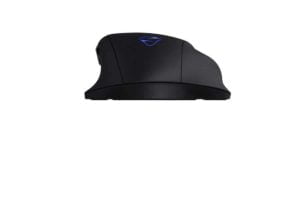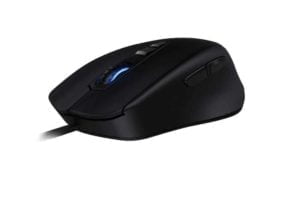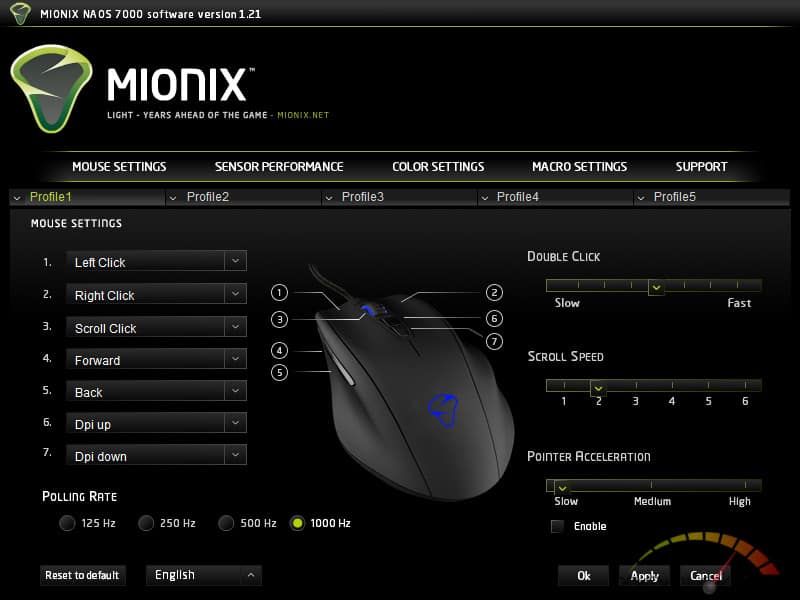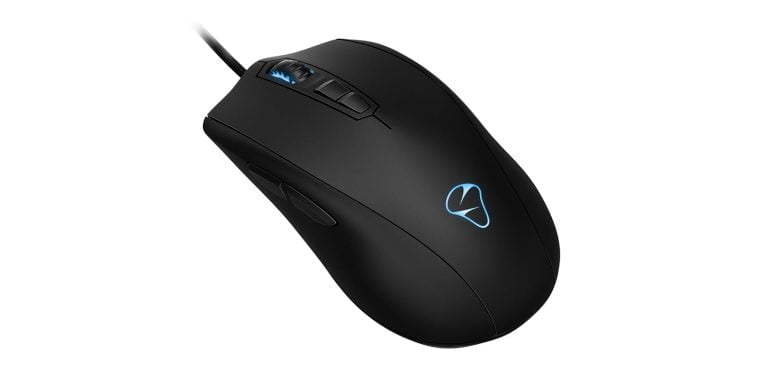All the subtle differences in human palm shapes, sizes, and grips make it virtually impossible to design a one-size-fits-all solution. That is why I am always skeptical whenever I come upon a gaming mouse advertised as “the most comfortable ergonomic mouse”. If this bold statement was not coming from Mionix, I would most certainly pass.
Mionix has been focusing on designing ergonomic gaming mice for quite some time striving to make the long gaming sessions an absolute joy. That is why I decided to give the Mionix NAOS 7000 a shot.
At first sight, this mouse has just the right bells and whistles any good gaming mouse should have: streamlined shape supporting all five fingers, gaming-grade optical sensor, 7 fully programmable buttons, and RGB lighting. However, some fingertip-grip fellow gamers who have small hands might find it a tad too large, with their palm heels hindering free mouse movements.
Ergonomics, Design and Build Quality

Mionix NAOS 7000’s body is entirely made of plastic, but don’t just yet assume it has that cheap-made look. It is covered with ultra-soft rubber velvet and feels premium like most expensive mice we have tested. However, you might find the surface a bit slippery, especially if you are into the habit of frequently lifting your mouse and readjusting its position on the pad.
The first thing that struck me was the mouse size. Its dimensions of 131 x 85 x 39mm secure it a spot in the large mice league. Its shape resembles competition’s Cooler Master MM520, but Mionix has taken the extra step to add a support swelling for the pinky finger. That’s what makes this rodent mostly suitable for palm-gripping, even though, hybrid- and claw-grips felt just as natural and comfortable.
It’s worth noting that the shape of this mouse was strictly designed with certain finger positions in mind. There is not much space left for improvisation. I know that some of you folks are used to resting their middle finger on the scroll wheel and use it intensively, so I benevolently tried to step into your shoes. I placed my middle finger on the scroll wheel, my ring finger on the right mouse button. That naturally left my pinky finger on the ring finger support swelling. Mildly put, this exercise felt quite uncomfortable. Besides, such finger setup makes lifting the mouse virtually impossible, unless you want your pinky being sore in a jiff.
The mouse weighs 103g without the cable, which is pretty close to the perfect 100-gram weight target for a gaming mouse. The braided cable is 2 meters long and has a Ferrite bead near the gold-plated USB 2.0 end.
Button placement and switches

Two 20-million lifespan click Omron switches bolster the left and right buttons. The rubberized tactile scroll wheel is non-tiltable, sturdy, and is not jitted out too much, which eliminates the possibility of unintentional scrolls. There are also 2 thumb rest buttons, and 2 DPI change buttons placed behind the scroll wheel.
In general, placing two buttons behind the scroll wheel makes the one positioned on the inside nearly impossible to reach without tediously twisting your pointer or middle finger. This potential drawback is avoided here. The large size of the mouse allows an easy access to the second button.
Performance and Sensor
Did you know that Mionix NAOS 7000 has a twin brother – the NAOS 8200 model? It was released back in 2012 and came out equipped with an Avago 9800 laser sensor which eventually turned a lot of gamers off. Its hardware acceleration caused a lot of trouble to competitive players, and the mouse was soon banished by the gaming community.
Nevertheless, Mionix learned a lesson and replaced the laser sensor in the 8200 model with the famous Avago ADNS-3310. For those of you who do not know, it is a gaming-grade, no-jitter, and super accurate sensor, which has practically become a standard in the gaming industry. As a result, we have an even deadlier gaming tool embodied in the NAOS 7000. Yes, the sensor swap means a decrease in the maximum achievable DPI, but effectively competitive gaming with anything over 3000 DPI simply means fewer frags for you and conscientiously gifting wins to the opposition.
The NAOS 7000 software allows for adjusting your DPI from 50 all the way up to the insane 7000, in 50-unit increments. Bear in mind that optical sensors are not good at tracking on glass or glossy surfaced desks. If that’s your case, either a cloth or a hard pad would do the job just fine.
Friction between your mouse and your pad will impact your aiming negatively and precision will deteriorate. To solve this issue Mionix went for placing quite large feet on the belly of this mouse, thus eliminating any potentially distracting grates and making movements feel well-greased.
Software and Customization

Plug the mouse, and it will start working right off the bat. However, I guess you may want to customize it at least a bit. For this purpose, you will have to download and install the NAOS 7000 Software from the Mionix support portal. Once you have it up and running, you can change sensor performance (separate X/Y sensitivity tuning is also possible), adjust lift-off-distance in tiny steps, modify scroll wheel speed, and program button functions. Being a wired mouse, it has a reporting rate of 1ms (1000Hz). You can lower it down to 125Hz for some old games do not play well with the default 1ms polling rate. In other words, you have complete control over mouse internals and behavior.
Moreover, the software has a tool, called Surface Quality Analyzer. It will assess sensor tracking data loss and depending on your pad you might get different scores. Higher numbers mean less data loss and more precise tracking; FPS players who are concerned about their in-game accuracy and receive grades under 7 out of the maximum 10 may want to replace their mat with a better one.
In terms of RGB lighting, there is nothing too lavish to see. The mouse has two illuminated color zones, both sporting 16.8 million color options – the mouse wheel and the logo on the heel spot. You can choose among a few lighting patterns: solid, blinking, pulsating and breathing color schemes.
The mouse features a 32-bit ARM processor and has an internal memory chip; its capacity of 128KB is more than enough to store all of your profile settings, macros, and key bindings.
Mionix NAOS 7000 vs 8200 vs Avior 8200 vs Castor vs G502
Final thoughts
Mionix NAOS 7000 might not be the cheapest optical mouse, but is definitely one of the best in the ergonomic mice market segment. Its unique shape makes it feel like a natural extension of your hand and a good fit for palm-grippers, who are mostly into FPS, RTS, and MOBA gaming genres. Its gaming-grade sensor, lots of fine-tune customization options, and the rest of the bells and whistles rank it as a high-quality gaming mouse that is quite a bang for your buck.


